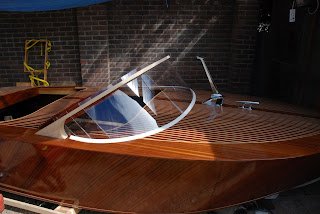CUT DOWN FRAME
I have reduced the width of the stainless steel canopy frame by taking a section of around 2ft out of the middle ,the two side sections will now be stainless welded along the center line .
From this angle you can see how neat the frame has ended up . It will be fixed to the deck with quick release deck hinges so i can detatch the whole frame and stow it away out of sight, but i have also designed it to fold flat behind the rear seats without being detatched for those showery days when it could be up and down all day.
Its July already and the UK weather is rubbish for varnishing boats so decided to get on with the canopy frame instead. I bought this stainless steel frame from a local boat jumble about a year ago and its been in storage since.As you can see from the picture it is way too big for my boat ,but as the uk weather is so unpredictable i think i need a canopy to protect from those showery days. Decided to cut down the bows which will reduce the width ,then i will get it stainless welded back together. I have suspended it from the carport roof so i can adjust the size to fit . more pics to follow as the canopy takes shape.
I have used an old sheet as a template to give me a better idea of how the canopy will look , may go with the three loop canopy frame as i want to cover both front and rear seats and three bows should give the fabric more support. The sheet is just taped in position at the moment which allows me to work around the boat making small adjustments to the shape as i go.
Front edge will be secured by concealed press studs under the bottom lip of the windscreen frame.
View looking from the rear seat , the canopy will be secured to the frame with some sewn in gussets that will snap popper around the roof bars .
























 .
.





























